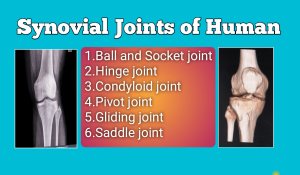There are six types of ( freely movable ) Synovial joints in Human
- 1. Ball and socket joint– Permitting movement in all directions, the ball and socket joint features the rounded head of one bone sitting in the cup of another bone. Examples Shoulder joint and Hip joint.
- 2. Hinge joint– The hinge joint is like a door, opening, and closing in one direction, along one plane. Examples Elbow joint, Knee joint, and Tibiotalar of the ankle joint.
- 3. Condyloid joint– The condyloid joint allows movement, but no rotation. Examples are Finger joints and Jaw.
- 4. Pivot joint– The pivot joint, also called the rotary joint or trochoid joint, Examples are the joint between the first cervical bone Atlas and second cervical bone Axis in the Neck/skull, (ie called First joint ) and the joints between the ulna and radius bones that rotate forearm.
- 5. Gliding joint– The gliding joint is also called the plane joint. It only permits limited movement, it’s characterized by smooth surfaces that can rotate over one another, An example is the joint in the Wrist joint.
- 6. Saddle joint– the Saddle joint does not allow rotation, it does enable movement back and forth and side to side. An example is the joint at the base of the Thumb.
- I hope guy’s like this post– Synovial joints in Human
